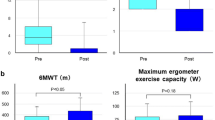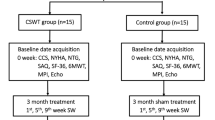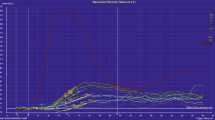Abstract
Our aim was to evaluate the safety and effectiveness of extracorporeal cardiac shock wave therapy (CSWT) for the patients with coronary heart disease (CHD) using a randomized, double-blind, controlled clinical trial design. Twenty-five patients with CHD were enrolled in this study. Fourteen of the patients were randomized into the CSWT group and 11 into the control group. We applied the CSWT procedure to each patient by using nine shock treatments during 3 months, but the shock wave (SW) energy was only applied to the patients in the CSWT group and not to the patients in the control group. Technetium-99m sestamibi myocardial perfusion, fluorine-18 fluorodeoxyglucose myocardial metabolism single-photon emission computed tomography (SPECT), and two-dimensional echocardiography were performed to identify segments of myocardial ischemia, myocardial viability, and ejection fraction before and after CSWT. We also followed the patients to evaluate adverse effects. After CSWT, the New York Heart Association class, the Canadian Cardiovascular Society angina scale, nitroglycerin dosage, myocardial perfusion and myocardial metabolic imaging scores of dual-isotope SPECT in the CSWT group were reduced significantly (P = 0.019, 0.027, 0.039, 0.000, 0.001, respectively), and the Seattle Angina Questionnaire scale, 6-min walking test, and left ventricular ejection fraction were increased significantly (P = 0.021, 0.024, 0.016, respectively) compared with those before the SW treatment. All of the parameters in the control group did not change significantly after the treatment (all P > 0.05). No serious adverse effects of CSWT were observed. Cardiac shock wave therapy is a safe and effective treatment for CHD patients.


Similar content being viewed by others
References
Iwasaki K, Matsumoto T, Aono H, Furukawa H, Nagamachi K, Samukawa M (2010) Distribution of coronary atherosclerosis in patients with coronary artery disease. Heart Vessels 25:14–18
Kayrak M, Bacaksiz A, Ulgen MS, Vatankulu MA, Zengin K, Ayhan SS, Basaral MK, Büyükbas S, Kiyici A (2011) Plasma concentrations of soluble CD40 ligand in smokers with acute myocardial infarction: a pilot study. Heart Vessels 26:131–137
Ichioka S, Shibata M, Kosaki K, Sato Y, Harii K, Kamiya A (1997) Effects of shear stress on wound healing angiogenesis in the rabbit ear chamber. J Surg Res 72:29–35
Fisher AB, Chien S, Barakat AI, Nerem RM (2001) Endothelial cellular response to altered shear stress. Am J Physiol Lung Cell Mol Physiol 281:L529–L533
Nishida T, Shimokawa H, Oi K, Tatewaki H, Uwatoku T, Abe K, Matsumoto Y, Kajihara N, Eto M, Matsuda T, Yasui H, Takeshita A, Sunaqawa K (2004) Extracorporeal cardiac shock wave therapy markedly ameliorates ischemia induced myocardial dysfunction in pigs in vivo. Circulation 110:3055–3061
Gutersohn A, Gaspari G (2000) Shock waves upregulate vascular endothelial growth factor m-RNA in human umbilical vascular endothelial cells. Circulation 102(suppl):1–18
Fukumoto Y, Ito A, Uwatoku T, Matoba T, Kishi T, Tanaka H, Takeshita A, Sunaqawa K, Shimokawa H (2006) Extracorporeal cardiac shock wave therapy ameliorates myocardial ischemia in patients with severe coronary artery disease. Coron Artery Dis 17:63–70
Khattab AA, Brodersen B, Schuermann-Kuchenbrandt D, Beurich H, Tölg R, Geist V, Schäfer T, Richardt G (2007) Extracorporeal cardiac shock wave therapy: first experience in the everyday practice for treatment of chronic refractory angina pectoris. Int J Cardiol 121:84–85
Ito K, Fukumoto Y, Shimokawa H (2009) Extracorporeal shock wave therapy as a new and non-invasive angiogenic therapy. Tohoku J Exp Med 219:1–9
Wang Y, Guo T, Cai HY, Ma TK, Tao SM, Sun S, Chen MQ, Gu Y, Pang JH, Xiao JM, Yang XY, Yang C (2010) Cardiac shock wave therapy reduces angina and improves myocardial function in patients with refractory coronary artery disease. Clin Cardiol 33:693–699
Vasyuk YA, Hadzegova AB, Shkolnik EL, Kopeleva MV, Krikunova OV, Iouchtchouk EN, Aronova EM, Ivanova SV (2010) Initial clinical experience with extracorporeal shock wave therapy in treatment of ischemic heart failure. Congest Heart Fail 16:226–230
Mariotto S, Cavalieri E, Amelio E, Ciampa AR, de Prati AC, Marlinghaus E, Russo S, Suzuki H (2005) Extracorporeal shock waves: from lithotripsy to anti-inflammatory action by NO production. Nitric Oxide 12:89–96
Ciampa AR, de Prati AC, Amelio E, Cavalieri E, Persichini T, Colasanti M, Musci G, Marlinghaus E, Suzuki S, Mariotto S (2005) Nitric oxide mediates anti-inflammatory action of extracorporeal shock waves. FEBS Lett 579:6839–6845
Oi K, Fukumoto Y, Ito K, Uwatoku T, Abe K, Hizume T, Shimokawa H (2008) Extracorporeal shock wave therapy ameliorates hindlimb ischemia in rabbits. Tohoku J Exp Med 214:151–158
Uwatoku T, Ito K, Abe K, Oi K, Hizume T, Sunagawa K, Shimokawa H (2007) Extracorporeal cardiac shock wave therapy proves left ventricular remodeling after acute myocardial infarction in pigs. Coron Artery Dis 18:397–404
Kikuchi Y, Ito K, Ito Y, Shiroto T, Tsuburaya R, Aizawa K, Hao K, Fukumoto Y, Takahashi J, Takeda M, Nakayama M, Yasuda S, Kuriyama S, Tsuji I, Shimokawa H (2010) Double-blind and placebo-controlled study of the effectiveness and safety of extracorporeal cardiac shock wave therapy for severe angina pectoris. Circ J 74:589–591
Cerqueira MD, Weissman NJ, Dilsizian V, Jacobs AK, Kaul S, Laskey WK, Pennell DJ, Rumberger JA, Ryan T, Verani MS (2002) American Heart Association Writing Group on Myocardial Segmentation and Registration for Cardiac Imaging. Standardized myocardial segmentation and nomenclature for tomographic imaging of the heart: a statement for healthcare professionals from the cardiac imaging committee of the Council on Clinical Cardiology of the American Heart Association. J Nucl Cardiol 9:240–245
Fang LG, Li J, Chen LB, Li F, Chen W, Fang Q (2009) Comparison of low-dose adenosine echocardiography and dual-isotope emission simultaneous acquisition for assessment of myocardial viability in early acute myocardial infarction. J Clin Cardiol (China) 25:623–626
Wang Y, Guo T, Cai HY, Ma TK, Tao SM, Chen MQ, Gu Y, Pan JH, Xiao JM, Zhao L, Yang XY, Yang C (2010) Extracorporeal cardiac shock wave therapy for treatment of coronary artery disease. Chin J Cardiol 38:711–715
Cai HY, Wang Y, Li L, Zhao L, Xiao JM, Cao JM, Yang XY, Yang C, Guo T (2010) Changes in the number of endothelial progenitor cells from peripheral blood in patients with coronary atherosclerotic heart disease before and after extracorporeal cardiac shock wave therapy. J Clin Rehabil Tissue Eng Res (China) 14:9249–9252
Tao SM, Gao T, Wang Y, Cai HY, Yang C (2011) Extracorporeal cardiac shock wave therapy improved myocardial micro-vascular circulation after acute myocardial infarction at early stage in pigs. J Sichuan Univ (Med Sci Edi) 42:222–226
Matsunari I, Kanayama S, Yoneyama T, Matsudaira M, Nakajima K, Taki J, Nekolla SG, Tonami N, Hisada K (2005) Electrocardiographic gated dual isotope simultaneous acquisition SPECT using 18F-FDG and 99mTc-sestamibi to assess myocardial viability and function in a single study. Eur J Nucl Med Mol Imaging 32:195–202
Slart RH, Bax JJ, de Boer J, Willemsen AT, Mook PH, Oudkerk M, Van der wall EE, Van Veld Huison DJ, Jaqer PL (2005) Comparison of 99mTc-sestamibi/18FDG DISA SPECT with PET for the detection of viability in patients with coronary artery disease and left ventricular dysfunction. Eur J Nucl Med Mol Imaging 32:972–979
Acknowledgments
We thank Dr Ernest H. Marlingghaus, Storze Medical AG, Switzerland and Kenta Ito, Department of Cardiovascular Medicine, Tohoku University Graduate School of Medicine, Japan, for their valuable help and comments to our study. This study was supported by the 1st Affiliated Hospital of Kunming Medical College, Kunming, Yunnan, China.
Author information
Authors and Affiliations
Corresponding author
Rights and permissions
About this article
Cite this article
Yang, P., Guo, T., Wang, W. et al. Randomized and double-blind controlled clinical trial of extracorporeal cardiac shock wave therapy for coronary heart disease. Heart Vessels 28, 284–291 (2013). https://doi.org/10.1007/s00380-012-0244-7
Received:
Accepted:
Published:
Issue Date:
DOI: https://doi.org/10.1007/s00380-012-0244-7




